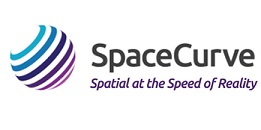 SpaceCurve announced availability of the first spatial data platform specifically engineered to organize and enable the analysis of large-scale spatial data. The platform delivers unprecedented time-to-value using space and time as the key indices for all associated data. SpaceCurve continuously fuses geospatial, sensor, IoT, social media, location, and other streaming and historical data while making the data immediately available for analytics and operational intelligence. SpaceCurve is live with partners including AirSage, L3, and Esri, and with customers in government, defense, transportation, and consumer marketing including Socrata, Dyn, Via Informatics, and IMS.
SpaceCurve announced availability of the first spatial data platform specifically engineered to organize and enable the analysis of large-scale spatial data. The platform delivers unprecedented time-to-value using space and time as the key indices for all associated data. SpaceCurve continuously fuses geospatial, sensor, IoT, social media, location, and other streaming and historical data while making the data immediately available for analytics and operational intelligence. SpaceCurve is live with partners including AirSage, L3, and Esri, and with customers in government, defense, transportation, and consumer marketing including Socrata, Dyn, Via Informatics, and IMS.
The Internet of Everything requires immediate analysis of sensor representations of the real world for a wide range of purposes, from understanding consumer behavior to optimizing oil and gas production. The ‘where’ and ‘when’ are not just coincidental attributes of the data that might be stored in the database, they are the primary attributes that drive high-value applications. Analysis of this data necessarily reflects the intrinsically spatial nature of the world we live in. Traditional data architectures weren’t designed to handle streaming sensor data with spatial and temporal attributes at the speed and scale required.
For example, telecommunications companies can now monitor network sensor data in real-time, detecting patterns of human migration to understand the density of people in a given location, physical or virtual, at a particular point in time to improve services. In transportation and logistics, the movement of people and products from one location to another can be optimized by fusing real-time environmental conditions, traffic flows, and any other operational factors to constantly determine the most economical routes possible.
The ability to contextualize almost any operational scenario by combining live sensor data with historical or slow moving data, at speed and scale, is game changing. Capturing insights from that data as events unfold and then making critical business decisions from this understanding of the world at the optimal point of impact is unprecedented. Leveraging data from the Internet of Things is expected to create trillions of dollars in new value across the global economy every year going forward. Current technologies and infrastructures are not ready for this wave.” said Dane Coyer, SpaceCurve CEO.
SpaceCurve was purpose-built for large volumes of high-velocity spatial data, such as sensor data, and the fusion of this data with any combination of other data sources (weather, economic, social media, images, and maps for example). SpaceCurve integrates every available data source in real-time while allowing immediate access to the live data model using standard interfaces such as SQL, REST, JSON, and ArcGIS.
SpaceCurve’s ability to continuously index and store this data concurrent with queries enables fast, interactive spatial analytics that cannot be achieved using technologies currently on the market. This is combined with a computational geometry engine that is uniquely capable of performant and ultra-precise spatial analysis operations to ensure maximum fidelity for applications with global scope.
The product includes a database engine designed to support the continuous ingestion and high-dimensionality indexing of spatial data at the extremely high data rates typical of machine-generated data sources. It also enables ad hoc queries and complex operations that run concurrent with data ingestion, immediately reflecting all new data. SpaceCurve has implemented a new approach to computational parallelism that enables highly scalable ingest, storage, and analysis of complex space and time relationships across diverse, very large data sources. This is all accomplished on commodity Linux clusters, either on customer premise or in the cloud.
Whether tracking the flow of populations and commerce throughout a city in order to understand complex consumer behaviors, or using remote sensing platforms to detect risks in agricultural supply chains, or combining aircraft sensor data with atmospheric measurements to optimize the fuel economy of flights in real-time, the ability to immediately measure and respond to changes in the environment will create incredible value. A significant challenge for addressing these business applications is selecting an infrastructure that can fully exploit the power of massive amounts of real-time sensor data. We believe SpaceCurve has created the most powerful solution to fulfill that promise,” continued Coyer.
Sign up for the free insideBIGDATA newsletter.




Speak Your Mind